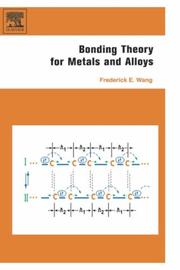| Listing 1 - 4 of 4 |
Sort by
|
Book
ISBN: 0444642021 0444642013 9780444642028 9780444642011 Year: 2019 Publisher: Amsterdam : Elsevier,
Abstract | Keywords | Export | Availability | Bookmark
 Loading...
Loading...Choose an application
- Reference Manager
- EndNote
- RefWorks (Direct export to RefWorks)
Bonding Theory for Metals and Alloys, 2e builds on the success of the first edition by introducing new experimental data to each chapter that support the breakthrough "Covalon" Conduction Theory developed by Dr. Wang. Through the recognition of the covalent bond in coexistence with the 'free' electron band, the book describes and demonstrates how the many experimental observations on metals and alloys can all be reconciled. Subsequently, it shows how the individual view of metals and alloys by physicists, chemists and metallurgists can be unified. This book covers such phenomena as the Miscibility Gap between two liquid metals, phase equilibrium, superconductivity, superplasticity, liquid metal embrittlement, and corrosion. The author also introduces a new theory based on 'Covalon' conduction, which forms the basis for a new approach to the theory of superconductivity. Bonding Theory for Metals and Alloys, 2e is of interest to physical and theoretical chemists alongside engineers working in research and industry, as well as materials scientists, physicists, and students at the upper undergraduate and graduate level in these fields.
Chemical bonds --- Mathematical models. --- Bonds, Chemical --- Chemical structure --- Chemistry, Physical and theoretical --- Overlap integral --- Quantum chemistry --- Valence (Theoretical chemistry)

ISBN: 9780444519788 0444519785 0080459730 9780080459738 9786610638413 1280638419 Year: 2005 Publisher: Amsterdam ; Oxford : Elsevier,
Abstract | Keywords | Export | Availability | Bookmark
 Loading...
Loading...Choose an application
- Reference Manager
- EndNote
- RefWorks (Direct export to RefWorks)
Bonding Theory for Metals and Alloys exhorts the potential existence of covalent bonding in metals and alloys. Through the recognition of the covalent bond in coexistence with the 'free' electron band, the book describes and demonstrates how the many experimental observations on metals and alloys can all be reconciled. Subsequently, it shows how the individual view of metals and alloys by physicists, chemists and metallurgists can be unified. The physical phenomena of metals and alloys covered in this book are: Miscibility Gap between two liquid metals; Phase Equilibrium Diagrams; Ph
Metallurgy --- Chemical bonds. --- Metal bonding. --- Alloys. --- Metallic alloys --- Metallic composites --- Metals --- Phase rule and equilibrium --- Amalgamation --- Microalloying --- Sealing (Technology) --- Bonds, Chemical --- Chemical structure --- Chemistry, Physical and theoretical --- Overlap integral --- Quantum chemistry --- Valence (Theoretical chemistry) --- Bonding
Digital
ISBN: 9780444642028 0444642021 9780444642011 0444642013 Year: 2019 Publisher: Netherlands Elsevier Science
Abstract | Keywords | Export | Availability | Bookmark
 Loading...
Loading...Choose an application
- Reference Manager
- EndNote
- RefWorks (Direct export to RefWorks)
Bonding Theory for Metals and Alloys, 2e builds on the success of the first edition by introducing new experimental data to each chapter that support the breakthrough "Covalon" Conduction Theory developed by Dr. Wang. Through the recognition of the covalent bond in coexistence with the 'free' electron band, the book describes and demonstrates how the many experimental observations on metals and alloys can all be reconciled. Subsequently, it shows how the individual view of metals and alloys by physicists, chemists and metallurgists can be unified. This book covers such phenomena as the Miscibility Gap between two liquid metals, phase equilibrium, superconductivity, superplasticity, liquid metal embrittlement, and corrosion. The author also introduces a new theory based on 'Covalon' conduction, which forms the basis for a new approach to the theory of superconductivity. Bonding Theory for Metals and Alloys, 2e is of interest to physical and theoretical chemists alongside engineers working in research and industry, as well as materials scientists, physicists, and students at the upper undergraduate and graduate level in these fields.

ISBN: 9780444519788 0444519785 0080459730 9780080459738 Year: 2005 Publisher: Boston Elsevier
Abstract | Keywords | Export | Availability | Bookmark
 Loading...
Loading...Choose an application
- Reference Manager
- EndNote
- RefWorks (Direct export to RefWorks)
Bonding Theory for Metals and Alloys exhorts the potential existence of covalent bonding in metals and alloys. Through the recognition of the covalent bond in coexistence with the 'free' electron band, the book describes and demonstrates how the many experimental observations on metals and alloys can all be reconciled. Subsequently, it shows how the individual view of metals and alloys by physicists, chemists and metallurgists can be unified. The physical phenomena of metals and alloys covered in this book are: Miscibility Gap between two liquid metals; Phase Equilibrium Diagrams; Phenomenon of Melting. Superconductivity; Nitinol; A Metal-Alloy with Memory; Mechanical Properties; Liquid Metal Embrittlement; Superplasticity; Corrosion; The author introduces a new theory based on 'Covalon' conduction, which forms the basis for a new approach to the theory of superconductivity. This new approach not only explains the many observations made on the phenomenon of superconductivity but also makes predictions that have been confirmed. * Openly recognizes the electrons as the most important and the only factor in understanding metals and alloys * Proposes "Covalon" conduction theory, which carries current in covalent bonded pairs * Investigates phase diagrams both from theoretical and experimental point of view.
| Listing 1 - 4 of 4 |
Sort by
|

 Search
Search Feedback
Feedback About UniCat
About UniCat  Help
Help News
News